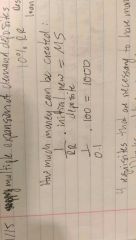![]()
![]()
![]()
Use LEFT and RIGHT arrow keys to navigate between flashcards;
Use UP and DOWN arrow keys to flip the card;
H to show hint;
A reads text to speech;
21 Cards in this Set
- Front
- Back
|
Monetary policy: list the major discretionary tools |
1. Federal reserve requirment 2. Discount rate/Federal funds rate 3. Federal open market operations |
|
|
How do the major monetary discretionary tools work to expand/contract money supply |
Increase reserve requirement - decrease money supply Decrease reserve requirement - increase money supply Increase discount rate (cursive r) - decrease money supply Decrease discount rate (cursive r) - increase money supply |
|
|
How do the buying/selling of government securities by the federal reserve affect money supply |
Increase money supply by buying bonds Decrease money supply by selling bonds |
|
|
Monetary policy: list 2 minor qualitative tools |
1. Moral suasion 2. Margin requirments on stock Market transactions |
|
|
Tools of fiscal policy: list 3 built in (auto/legeslation has already passed) stabilizers & how they expand/contract the money supply (GDP) |
1. Farm aid i. Income falls payments made automatically i. Price supports price wheat goes down subsidies i 2. Unemployment compensation i. High unemployment low GDP compensation payments are made (increases the C component of total spending) d. Unemployment taxes increase when employment high 3. Progressive graduated tax structure (automatic changes in tax receipts) i. Income i, i in tax receipts d. Income d, d in taxes |
|
|
Tools of fiscal policy: list 3 built in discretionary (need legeslative action/new legislation) stabilizers |
1. Varying public works and other expenditure programs i. Expand public works (increase G component) d. Stop public works (especially in an inflationary situation) 2. Varying welfare or other expenditure programs i. Veterans bonuses, parody payments to farmers, amnt/duration of unemploment comp 3. Government can change the tax rate structure National sales tax, change tax rate, change whole structure |
|
|
What is the most important regulation tool? |
Federal open market regulation |
|
|
List the functions of money |
1. Medium of exchange 2. Convenience 3. Uniformity 4. Accuracy & divisibility 5. Durability |
|
|
List the components of money (OCD's) |
Coins, currency, demand deposits |
|
|
2 major components of near money |
U.S. government security Time and savings accounts |
|
|
Explain concept of near money |
Near money is less liquid (Porsche example) |
|
|
5 ways that monetary policy works to expand GDP |
1. i reserves available to member banks a. i reserve requirements b. d discount/Federal fund rate c. Buy bonds 2. Expansion of deposit based on the ability of the banks to loan 3. i money supply; decrease cursive i 4. d cursive i, investment i, government i 5. i I&G - i GDP |
|
|
How much money can be created based on reserve requirement |

|
|
|
4 requisites that are necessary for money to expand |
1. Banks must have new reserves 2. Banks must loan money 3. Individuals must borrow money 4. Individuals must be willing to leave money on account |
|
|
Define 1. Inflation 2. Deflation |
1. Rise in general price level 2. General price level falls |
|
|
Who are adversely/beneficially affected by inflation |
Benefit: profit receivers, debtors Adverse: fixed income reciepients, creditors |
|
|
Quantity theory of money (equasion of exchange) |
MV=PQ (Money supply)(income velocity of circulation)=(General price level)(quantity of goods) How many times it changes hands over a year=GDP |
|
|
2 forms of legal reserve that banks accept |
Vault cash Banks accounts with Federal reserve |
|
|
Describe the effects of excess reserves on the relative success of monetary policy aimed to contract the money supply |
If monetary policy is going to be effective then the Federal reserve must be able to control the banks excess reserves (bonds and loans) |
|
|
Business cycles: external (exogenous) |
External effects from outside the system ex: wars, climate change, sunspots, scientific discoveries |
|
|
Business cycles: internal (endogenous) |
Internal affects from within ex: over investment, psychological self generation |

